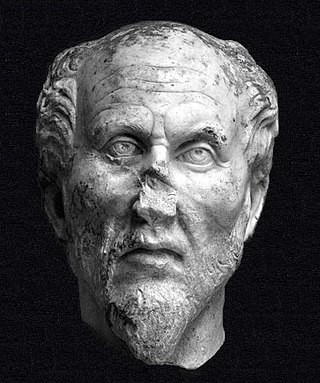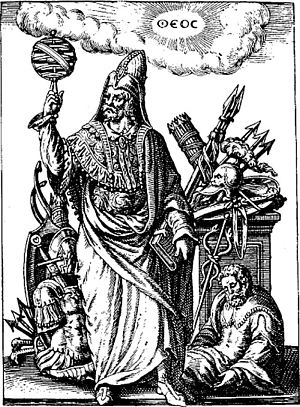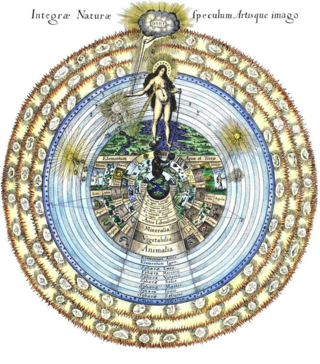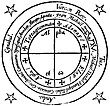In the Platonic, Neopythagorean, Middle Platonic, and Neoplatonic schools of philosophy, the demiurge is an artisan-like figure responsible for fashioning and maintaining the physical universe. The Gnostics adopted the term demiurge. Although a fashioner, the demiurge is not necessarily the same as the creator figure in the monotheistic sense, because the demiurge itself and the material from which the demiurge fashions the universe are both considered consequences of something else. Depending on the system, they may be considered either uncreated and eternal or the product of some other entity.

Plotinus was a Greek Platonist philosopher, born and raised in Roman Egypt. Plotinus is regarded by modern scholarship as the founder of Neoplatonism. His teacher was the self-taught philosopher Ammonius Saccas, who belonged to the Platonic tradition. Historians of the 19th century invented the term "neoplatonism" and applied it to refer to Plotinus and his philosophy, which was vastly influential during late antiquity, the Middle Ages, and the Renaissance. Much of the biographical information about Plotinus comes from Porphyry's preface to his edition of Plotinus' most notable literary work, The Enneads. In his metaphysical writings, Plotinus described three fundamental principles: the One, the Intellect, and the Soul. His works have inspired centuries of pagan, Jewish, Christian, Gnostic, and early Islamic metaphysicians and mystics, including developing precepts that influence mainstream theological concepts within religions, such as his work on duality of the One in two metaphysical states.

Hermeticism, or Hermetism, is a philosophical and religious tradition rooted in the teachings attributed to Hermes Trismegistus, a syncretic figure combining elements of the Greek god Hermes and the Egyptian god Thoth. This system encompasses a wide range of esoteric knowledge, including aspects of alchemy, astrology, and theurgy, and has significantly influenced various mystical and occult traditions throughout history. The writings attributed to Hermes Trismegistus, often referred to as the Hermetica, were produced over a period spanning many centuries and may be very different in content and scope.
Thaumaturgy, derived from the Greek words thauma (wonder) and ergon (work), refers to the practical application of magic to effect change in the physical world. Historically, thaumaturgy has been associated with the manipulation of natural forces, the creation of wonders, and the performance of magical feats through esoteric knowledge and ritual practice. Unlike theurgy, which focuses on invoking divine powers, thaumaturgy is more concerned with utilizing occult principles to achieve specific outcomes, often in a tangible and observable manner. It is sometimes translated into English as wonderworking.
The following outline is provided as an overview of and topical guide to spirituality:

Iamblichus was a Syrian neoplatonic philosopher. He determined a direction later taken by neoplatonism. Iamblichus was also the biographer of the Greek mystic, philosopher, and mathematician Pythagoras. In addition to his philosophical contributions, his Protrepticus is important for the study of the sophists because it preserved about ten pages of an otherwise unknown sophist known as the Anonymus Iamblichi.
The Bornless Ritual, also known as the Preliminary Invocation of the Goetia or simply Preliminary Invocation, originates from the Graeco-Egyptian Papyri Graecae Magicae (PGM), a collection of ancient spells, invocations, and hymns compiled between the 2nd century BCE and the 5th century CE. Initially used for exorcism and healing, the ritual invokes the "Bornless" or "Headless One", a transcendent deity beyond birth and death, symbolizing the unity of the divine and practitioner. Some interpretations suggest that the ritual may have connections with the Egyptian god Set. It is also called the "Headless Rite" or the "Invocation of the Bornless One".

The concept of the anima mundi (Latin), world soul, or soul of the world posits an intrinsic connection between all living beings, suggesting that the world is animated by a soul much like the human body. Rooted in ancient Greek and Roman philosophy, the idea holds that the world soul infuses the cosmos with life and intelligence. This notion has been influential across various systems of thought, including Stoicism, Gnosticism, Neoplatonism, and Hermeticism, shaping metaphysical and cosmological frameworks throughout history.
Asclepigenia was an Athenian philosopher and mystic.
Gnosticism refers to a collection of religious groups originating in Jewish religiosity in Alexandria in the first few centuries AD. Neoplatonism is a school of Hellenistic philosophy that took shape in the 3rd century, based on the teachings of Plato and some of his early followers. While Gnosticism was influenced by Middle Platonism, neoplatonists from the third century onward rejected Gnosticism. Nevertheless, Alexander J. Mazur argues that many neoplatonic concepts and ideas are ultimately derived from Sethian Gnosticism during the third century in Lower Egypt, and that Plotinus himself may have been a Gnostic before nominally distancing himself from the movement.
Eusebius of Myndus was a 4th-century philosopher, a distinguished Neoplatonist. He is described by Eunapius as one of the links in the "Golden Chain" of Neoplatonism.

The body of light, sometimes called the 'astral body' or the 'subtle body,' is a "quasi material" aspect of the human body, being neither solely physical nor solely spiritual, posited by a number of philosophers, and elaborated on according to various esoteric, occult, and mystical teachings. Other terms used for this body include body of glory, spirit-body, luciform body, augoeides, astroeides, and celestial body.

Jewish meditation includes practices of settling the mind, introspection, visualization, emotional insight, contemplation of divine names, or concentration on philosophical, ethical or mystical ideas. Meditation may accompany unstructured, personal Jewish prayer, may be part of structured Jewish services, or may be separate from prayer practices. Jewish mystics have viewed meditation as leading to devekut. Hebrew terms for meditation include hitbodedut or hitbonenut/hisbonenus ("contemplation").

This is a comparative religion article which outlines the similarities and interactions between Hermeticism and other religions or philosophies. It highlights its similarities and differences with Gnosticism, examines its connections in Islam and Judaism, delves into its influence on Christianity, and even explores its potential impact on Mormonism. In essence, it unveils how Hermeticism has engaged with, influenced, and been influenced by a diverse array of spiritual and philosophical traditions throughout history.
Henosis is the classical Greek word for mystical "oneness", "union" or "unity". In Neoplatonism, henosis is unification with what is fundamental in reality: the One, the Source, or Monad. The Neoplatonic concept has precedents in the Greek mystery religions as well as parallels in Eastern philosophy. It is further developed in the Corpus Hermeticum, in Christian theology, Islamic Mysticism, soteriology and mysticism, and is an important factor in the historical development of monotheism during Late Antiquity.

Hermetic Qabalah is a Western esoteric tradition involving mysticism and the occult. It is the underlying philosophy and framework for magical societies such as the Hermetic Order of the Golden Dawn, has inspired esoteric Masonic organizations such as the Societas Rosicruciana in Anglia, is a key element within the Thelemic orders, and is important to mystical-religious societies such as the Builders of the Adytum and the Fellowship of the Rosy Cross.

Plutarch of Athens was a Greek philosopher and Neoplatonist who taught in Athens at the beginning of the 5th century. He reestablished the Platonic Academy there and became its leader. He wrote commentaries on Aristotle and Plato, emphasizing the doctrines which they had in common.
Neoplatonism is a version of Platonic philosophy that emerged in the 3rd century AD against the background of Hellenistic philosophy and religion. The term does not encapsulate a set of ideas as much as a series of thinkers. Among the common ideas it maintains is monism, the doctrine that all of reality can be derived from a single principle, "the One".
The Chaldean Oracles are a set of spiritual and philosophical texts widely used by Neoplatonist philosophers from the 3rd to the 6th century CE. While the original texts have been lost, they have survived in the form of fragments consisting mainly of quotes and commentary by Neoplatonist writers. They were likely to have originally formed a single mystery-poem, which may have been in part compiled, in part received via trance, by Julian the Chaldean, or more likely, his son, Julian the Theurgist in the 2nd century CE. Later Neoplatonists, such as Iamblichus and Proclus, rated them highly. The 4th-century emperor Julian suggests in his Hymn to the Magna Mater that he was an initiate of the God of the Seven Rays, and was an adept of its teachings. When Christian Church Fathers or other Late Antiquity writers credit "the Chaldeans", they are probably referring to this tradition.

"What Is Theosophy?" is an editorial published in October 1879 in the Theosophical magazine The Theosophist. It was compiled by Helena Blavatsky and included into the 2nd volume of the Blavatsky Collected Writings. According to a doctoral thesis by Tim Rudbøg, in this "important" article Blavatsky "began conceptualizing her idea of 'Theosophy'."









